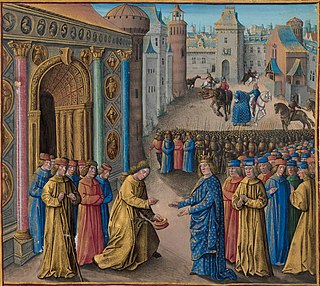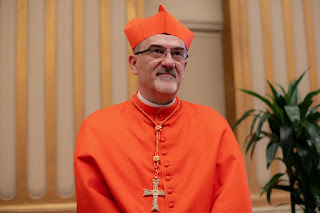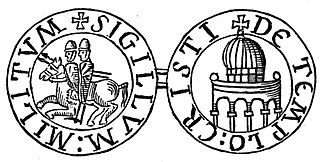William of Malines | |
|---|---|
| Latin Patriarch of Jerusalem | |
| Archdiocese | Latin Patriarchate of Jerusalem |
| Appointed | Pope Innocent II |
| In office | 1130–1145/6 |
| Predecessor | Stephen of La Ferté |
| Successor | Fulk of Angoulême |
| Other post(s) | Prior of the Church of the Holy Sepulchre (1127-1130) |
| Orders | |
| Ordination | Augustinian Canons |
| Personal details | |
| Died | 1145/6 |
William of Malines (or William of Messines) (died 1145/6) was a Flemish priest who was the Prior of the Church of the Holy Sepulchre from 1127 to 1130 and was then Latin Patriarch of Jerusalem from 1130 until his death. He is sometimes called William I to distinguish him from William of Agen, second patriarch of that name, but he was the second William to serve as prior of the Holy Sepulchre after William the Englishman. [1]
William of Tyre described William of Mesines as a man of "praiseworthy habits". [2] As patriarch, he was an important supporter of Queen Melisende and is described as a man capable yet pliable. [3] He received a letter from Bernard of Clairvaux urging him to support the Knights Templar, who had received their papal privileges at the same time as William's embassy to Rome. [4] William took the initiative in constructing a castle, the "Castrum Arnaldi" (or Chastel Arnoul) at Yalo, to guard the road between Jerusalem and Jaffa in 1132–33, along with some citizens. It was later a Templar stronghold. [5] William was on good terms with his successor Peter and in 1134 he gave the canons of the Holy Sepulchre the charge of the shrine of the Mount of Temptation who agreed to found a daughter house there. [6] He also sanctioned the formation of a confraternity between the four communities of Augustinian canons in Jerusalem (those of the Holy Sepulchre, the Templum Domini, the Mount of Olives and Mt Zion) at some point between 1130 and 1136. [7]
In 1139 Patriarch William was displeased by the actions of Archbishop Fulcher of Tyre (of Angoulême), who travelled to Rome to receive his pallium from Pope Honorius II and protest the division of his archdiocese into two ecclesiastical territories: the northern suffragans were under the authority of the Latin patriarch of Antioch and only the southern sees remained under Fulcher's control. Perhaps fearing that Fulcher would try to remove his entire archdiocese to the Principality of Antioch (so that he might exercise control over it all as archbishop), William took direct control over the southern sees of Tyre in Fulcher's absence, [8] for William would not allow the archbishop of Tyre, whose archdiocese lay within the boundaries of the Kingdom of Jerusalem and his patriarchate, to become the subject of another. [9]
In April 1141 the papal legate Alberic of Ostia arrived together with the Armenian Catholicos Gregory III and convened a legatine council in the Templum Domini. [10] [11] Here the question over the jurisdiction was settled and the claim of Antioch's patriarch Ralph of Domfront to the diocese of Tyre rejected. [12]

The Kingdom of Jerusalem, also known as the Latin Kingdom, was a Crusader state that was established in the Levant immediately after the First Crusade. It lasted for almost two hundred years, from the accession of Godfrey of Bouillon in 1099 until the fall of Acre in 1291. Its history is divided into two periods with a brief interruption in its existence, beginning with its collapse after the siege of Jerusalem in 1187 and its restoration after the Third Crusade in 1192.

William of Tyre was a medieval prelate and chronicler. As archbishop of Tyre, he is sometimes known as William II to distinguish him from his predecessor, William I, the Englishman, a former prior of the Church of the Holy Sepulchre, who was Archbishop of Tyre from 1127 to 1135. He grew up in Jerusalem at the height of the Kingdom of Jerusalem, which had been established in 1099 after the First Crusade, and he spent twenty years studying the liberal arts and canon law in the universities of Europe.

Raymond of Poitiers was Prince of Antioch from 1136 to 1149. He was the younger son of William IX, Duke of Aquitaine, and his wife Philippa, Countess of Toulouse, born in the very year that his father the Duke began his infamous liaison with Dangereuse de Chatelherault.

Bohemond II was Prince of Taranto from 1111 to 1128 and Prince of Antioch from 1111/1119 to 1130. He was the son of Bohemond I, who in 1108 was forced to submit to the authority of the Byzantine Empire in the Treaty of Devol. Three years later, the infant Bohemond inherited the Principality of Taranto under the guardianship of his mother, Constance of France. The Principality of Antioch was administered by his father's nephew, Tancred, until 1111. Tancred's cousin, Roger of Salerno, managed the principality from 1111 to 1119. After Roger died in the Battle of the Field of Blood, Baldwin II of Jerusalem took over the administration of Antioch. However, he did acknowledge Bohemond's right to personally rule the principality upon reaching the age of majority.

The Latin Patriarchate of Jerusalem is the Latin Catholic ecclesiastical patriarchate in Jerusalem, officially seated in the Church of the Holy Sepulchre. It was originally established in 1099, with the Kingdom of Jerusalem encompassing the territories in the Holy Land newly conquered by the First Crusade. From 1374 to 1847 it was a titular see, with the patriarchs of Jerusalem being based at the Basilica di San Lorenzo fuori le Mura in Rome. Pope Pius IX re-established a resident Latin patriarch in 1847.

Baldwin II, also known as Baldwin of Bourcq or Bourg, was Count of Edessa from 1100 to 1118, and King of Jerusalem from 1118 until his death. He accompanied his cousins Godfrey of Bouillon and Baldwin of Boulogne to the Holy Land during the First Crusade. He succeeded Baldwin of Boulogne as the second count of Edessa when he left the county for Jerusalem following his brother's death. He was captured at the Battle of Harran in 1104. He was held first by Sökmen of Mardin, then by Jikirmish of Mosul, and finally by Jawali Saqawa. During his captivity, Tancred, the Crusader ruler of the Principality of Antioch, and Tancred's cousin, Richard of Salerno, governed Edessa as Baldwin's regents.
The Canons Regular of the Holy Sepulchre were a Catholic religious order of canons regular of the Rule of Saint Augustine, said to have been founded in the Church of the Holy Sepulchre in Jerusalem, then the capital of the Kingdom of Jerusalem, and recognised in 1113 by a Papal bull of Pope Paschal II. Other accounts have it that they were founded earlier, during the rule of Godfrey of Bouillon (1099–1100).
The See of Tyre was one of the most ancient dioceses in Christianity. The existence of a Christian community there in the time of Saint Paul is mentioned in the Acts of the Apostles. Seated at Tyre, which was the capital of the Roman province of Phoenicia Prima, the bishopric was a metropolitan see. Its position was briefly challenged by the see of Berytus in the mid-5th century; but after 480/1 the metropolitan of Tyre established himself as the first (protothronos) of all those subject to the Patriarch of Antioch.
Alberic of Ostia (1080–1148) was a Benedictine monk, diplomat and Cardinal Bishop of Ostia from 1138 to 1148. He was one of the most important people in the administration of Pope Eugenius III, especially due to his diplomatic skills.
Warmund, also Garmond, Gormond, Germond, Guarmond or Waremond, was the Latin Patriarch of Jerusalem from 1118 until his death at Sidon in 1128.
Fulkof Angoulême was the Latin Patriarch of Jerusalem from 1146 to his death in 1157.

The Templum Domini was the name attributed by the Crusaders to the Dome of the Rock in Jerusalem. It became an important symbol of Jerusalem, depicted on coins minted under the Catholic Christian Kingdom of Jerusalem.
Ralph of Domfront was the archbishop of Mamistra and second Latin patriarch of Antioch from 1135 until 1140. William of Tyre describes him as "a military man, very magnificent and generous, a great favourite of the common people and with those of knightly birth."

The timeline of the Kingdom of Jerusalem presents important events in the history of the Kingdom of Jerusalem—a Crusader state in modern day Israel and Jordan—in chronological order. The kingdom was established after the First Crusade in 1099. Its first ruler Godfrey of Bouillon did not take the title of king and swore fealty to the Latin Patriarch of Jerusalem, Daimbert. Godfrey's brother and successor Baldwin I was crowned the first king of Jerusalem without doing homage to the patriarch in 1100. By 1153, Baldwin I and his successors captured all towns on the Palestinian coast with the support of Pisan, Genoese and Venetian fleets and also took control of the caravan routes between Egypt and Syria. The kings regularly administered other crusader states—the Counties of Edessa and Tripoli and the Principality of Antioch—on behalf of their absent or underage rulers.
The Roman Catholic Diocese of Sidon was a bishopric in the Kingdom of Jerusalem in the 12th and 13th centuries.
The Roman Catholic Archdiocese of Tyre was an archbishopric in the Kingdom of Jerusalem.
William I was the second Latin archbishop of Tyre from 1128 until 1134 or 1135. He was originally from England and served as prior of the Church of the Holy Sepulchre before his appointment as archbishop.
Latin Diocese of Tortosa in Syria was a Roman Catholic diocese established in the Syrian city of Tartus after the First Crusade. It had a resident bishop between 1128 and 1291. The cathedral of Tortosa became the site of a Marian shrine.
The Abbey of Saint Lazarus was a Benedictine convent in Bethany in the Kingdom of Jerusalem. It was founded in 1138 by Queen Melisende and King Fulk at the reputed site of the tomb of Lazarus. The queen lavishly endowed the abbey, making it richer than any other religious community in the kingdom. It lost much of its estates, including Bethany itself, during the Muslim reconquests of the Latin East, and retreated to the Kingdom of Cyprus, where it faded into obscurity in the 14th century. Parts of the abbey buildings are still visible in Bethany.
Stephanie of Courtenay was a Latin noblewoman from the crusader states who served as the abbess of Great Saint Mary's in Jerusalem. She belonged to the House of Courtenay which ruled the County of Edessa and worked to further her abbey's wealth and standing. She is best known as a source of information for William of Tyre's chronicle of the crusader states.